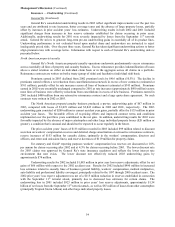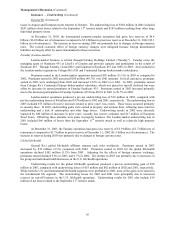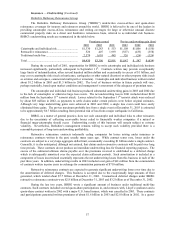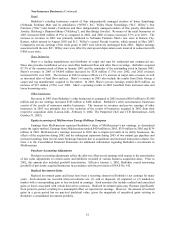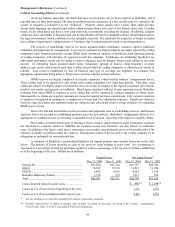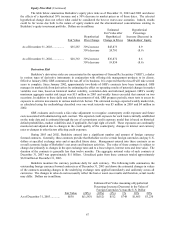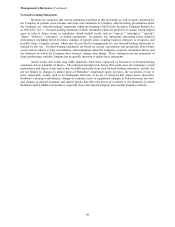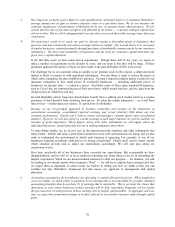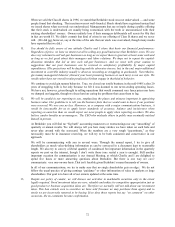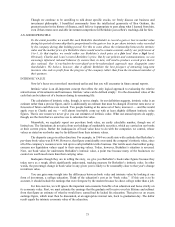Berkshire Hathaway 2003 Annual Report Download - page 64
Download and view the complete annual report
Please find page 64 of the 2003 Berkshire Hathaway annual report below. You can navigate through the pages in the report by either clicking on the pages listed below, or by using the keyword search tool below to find specific information within the annual report.
63
Financial Condition (Continued)
2008 through 2013. The proceeds of these issues were used to finance new and existing loans of Clayton. The
medium term notes are guaranteed by Berkshire. Additional borrowings are expected in the future as retained loan
portfolios continue to increase.
Berkshire believes that it currently maintains sufficient liquidity to cover its existing requirements and
provide for contingent liquidity.
Contractual Obligations
Berkshire and its subsidiaries have contractual obligations associated with ongoing business and financing
activities, which will result in cash payments in future periods. Certain of those obligations, such as notes payable
and other borrowings and related interest payments, are reflected in the Consolidated Financial Statements. In
addition, Berkshire and subsidiaries have entered into long-term contracts to acquire goods or services in the future,
which are not currently reflected in the financial statements and will be reflected in future periods as the goods are
delivered or services provided. A summary of contractual obligations follows. Amounts are in millions.
Payments due by period
Contractual obligations Total 2004 2005-2006 2007-2008 2009 and after
Notes payable and other borrowings (1).................... $12,107 $ 3,225 $1,015 $2,104 $5,763
Securities sold under agreements to repurchase (1)... 7,958 7,958 — — —
Operating leases....................................................... 1,508 322 505 334 347
Purchase obligations (2) ............................................ 6,842 2,561 1,808 1,418 1,055
Other (3) .................................................................... 924 202 173 125 424
Total......................................................................... $29,339 $14,268 $3,501 $3,981 $7,589
(1) Includes interest
(2) Principally relates to NetJets aircraft purchases
(3) Principally employee benefits and deferred compensation
Critical Accounting Policies
In applying certain accounting policies, Berkshire’ s management is required to make estimates and
judgments regarding transactions that have occurred and ultimately will be settled several years in the future.
Amounts recognized in the financial statements from such estimates are necessarily based on assumptions about
numerous factors involving varying, and possibly significant, degrees of judgment and uncertainty. Accordingly,
the amounts currently recorded in the financial statements may prove, with the benefit of hindsight, to be inaccurate.
The balance sheet items most significantly affected by these estimates are property and casualty insurance and
reinsurance related liabilities.
Berkshire records liabilities for unpaid losses and loss adjustment expenses under property and casualty
insurance and reinsurance contracts based upon estimates of the ultimate amounts payable under the contracts
related to losses occurring on or before the balance sheet date. Berkshire uses a variety of techniques to establish
and review the liabilities for unpaid losses recorded as of the balance sheet date. While techniques may vary,
significant judgments and assumptions are necessary in projecting the ultimate amount payable in the future with
respect to loss events that have occurred as of the balance sheet date.
Reserves for unpaid losses and loss adjustment expenses are established by policy type (or line) or
individual coverage within the policy type. Reserves may consist of individual case estimates, supplemental case
estimates, development estimates and incurred-but-not-reported (“IBNR”) claim estimates. Once reported, certain
casualty claims may take years to settle, especially if legal action is involved. Liabilities may also reflect implicit or
explicit assumptions regarding the potential effects of future economic and social inflation, judicial decisions, law
changes, and recent trends in such factors.
Berkshire uses a variety of techniques as tools in establishing and evaluating aggregate reserve amounts.
Techniques used vary within each business depending upon the availability of reliable information. Statistical
techniques may include detailed analysis of historical amounts of losses incurred or paid, claim frequency and
severity data, average paid or incurred loss data, closed claim data, paid or incurred loss ratios or other
measurements. Statistical techniques are more reliable when a sufficient volume of historical loss information
exists. Significant changes to policy terms or coverages or in volumes of business written (and, therefore, loss
exposures), or changes in the insurance laws or legal environment can cause historical statistical data to be less
reliable in projecting the ultimate amount of losses as of the balance sheet date. Statistical analysis may be based
upon internally developed loss experience, the experience of individual clients or groups of clients, or overall
industry-wide experience. Reserving techniques are based more upon informed judgment when statistical data is
insufficient or unavailable. Management must make judgments regardless of the techniques used.



